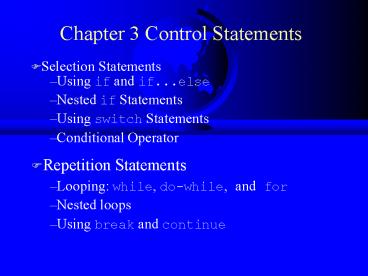Chapter 3 Control Statements - PowerPoint PPT Presentation
1 / 18
Title:
Chapter 3 Control Statements
Description:
Chapter 3 Control Statements Selection Statements Using if and if...else Nested if Statements Using switch Statements Conditional Operator Repetition Statements – PowerPoint PPT presentation
Number of Views:144
Avg rating:3.0/5.0
Title: Chapter 3 Control Statements
1
Chapter 3 Control Statements
- Selection Statements
- Using if and if...else
- Nested if Statements
- Using switch Statements
- Conditional Operator
- Repetition Statements
- Looping while, do-while, and for
- Nested loops
- Using break and continue
2
Repetitions
- while Loops
- do-while Loops
- for Loops
- break and continue
3
while Loop Flow Chart
while (continuation-condition) // loop-body
4
while Loop Flow Chart, cont.
int i 0 while (i lt 100) System.out.println(
"Welcome to Java!") i
5
Example 3.2 Using while Loops
// TestWhile.java Test the while loop import
javax.swing.JOptionPane public class TestWhile
/ Main method / public static void
main(String args) int data int sum
0 // Read an initial data String
dataString JOptionPane.showInputDialog(null,
"Enter an int value, \nthe program exits if
the input is 0", "Example 3.2 Input",
JOptionPane.QUESTION_MESSAGE) data
Integer.parseInt(dataString) // Keep reading
data until the input is 0 while (data ! 0)
sum data // Read the next data
dataString JOptionPane.showInputDialog(null
, "Enter an int value, \nthe program
exits if the input is 0", "Example 3.2
Input", JOptionPane.QUESTION_MESSAGE) data
Integer.parseInt(dataString)
JOptionPane.showMessageDialog(null, "The sum is "
sum, "Example 3.2 Output",
JOptionPane.INFORMATION_MESSAGE)
System.exit(0)
6
Caution
- Dont use floating-point values for equality
checking in a loop control. Since floating-point
values are approximations, using them could
result in imprecise counter values and inaccurate
results. This example uses int value for data. If
a floating-point type value is used for data,
(data ! 0) may be true even though data is 0. - // data should be zero
- double data Math.pow(Math.sqrt(2), 2) - 2
- if (data 0)
- System.out.println("data is zero")
- else
- System.out.println("data is not zero")
7
do-while Loop
do // Loop body while (continue-condition)
8
for Loops
- for (initial-action loop-continuation-condition
action-after-each-iteration) - //loop body
- int i 0
- while (i lt 100)
- System.out.println("Welcome to Java! i)
- i
- Example
- int i
- for (i 0 i lt 100 i)
- System.out.println("Welcome to Java! i)
9
for Loop Flow Chart
for (initial-action loop-continuation-conditio
n action-after-each-iteration) //loop
body
10
for Loop Example
int i for (i 0 ilt100 i)
System.out.println( "Welcome to Java")
11
Which Loop to Use?
The three forms of loop statements, while, do,
and for, are expressively equivalent that is,
you can write a loop in any of these three forms.
I recommend that you use the one that is most
intuitive and comfortable for you. In general, a
for loop may be used if the number of repetitions
is known, as, for example, when you need to print
a message 100 times. A while loop may be used if
the number of repetitions is not known, as in the
case of reading the numbers until the input is 0.
A do-while loop can be used to replace a while
loop if the loop body has to be executed before
testing the continuation condition.
12
Caution
- Adding a semicolon at the end of the for clause
before the loop body is a common mistake, as
shown below - for (int i0 ilt10 i)
- System.out.println("i is " i)
Wrong
13
Caution, cont.
- Similarly, the following loop is also wrong
- int i0
- while (ilt10)
- System.out.println("i is " i)
- i
- In the case of the do loop, the following
semicolon is needed to end the loop. - int i0
- do
- System.out.println("i is " i)
- i
- while (ilt10)
Wrong
Correct
14
The break Keyword
15
The continue Keyword
16
Using break
Example for using the break keyword 3.5
// TestBreak.java Test the break keyword in the
loop public class TestBreak / Main method
/ public static void main(String args)
int sum 0 int item 0 while (item lt
5) item sum item //if
(sum gt 6) break System.out.println("Th
e sum is " sum)
17
Using continue
Example for using the continue keyword
// TestContinue.java Test the continue
keyword public class TestContinue / Main
method / public static void main(String
args) int sum 0 int item 0
while (item lt 5) item if (item
2) continue sum item
System.out.println("The sum is " sum)
18
Review of Terms Deenas Class
- The 3 essential elements of a programming loop
priming, test, and update - User-controlled loops vs Program-controlled loops
- Some user-controlled loops use sentinels.
- Accumulator and Marker variables how are these
used in loops? - What is a flag variable? When do you use it?

